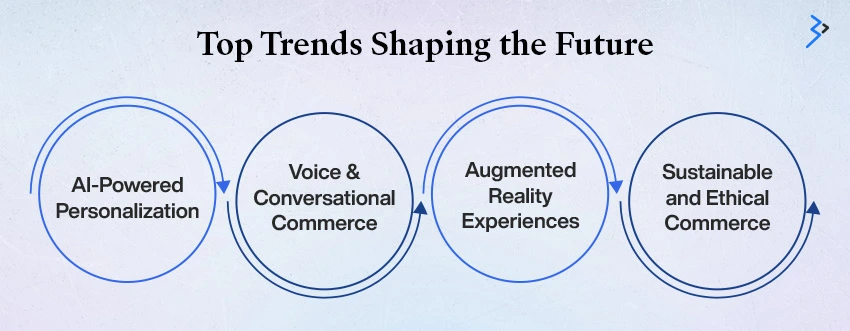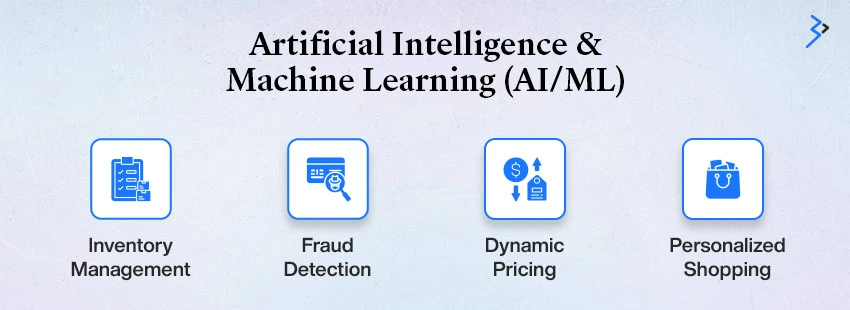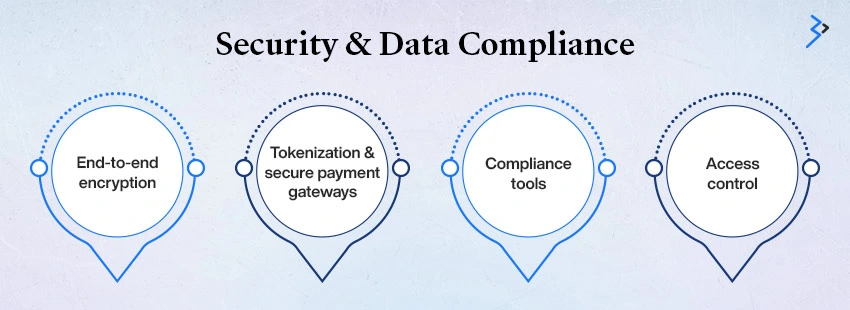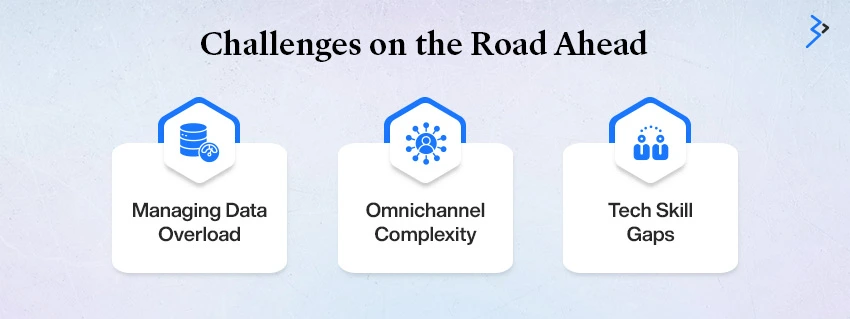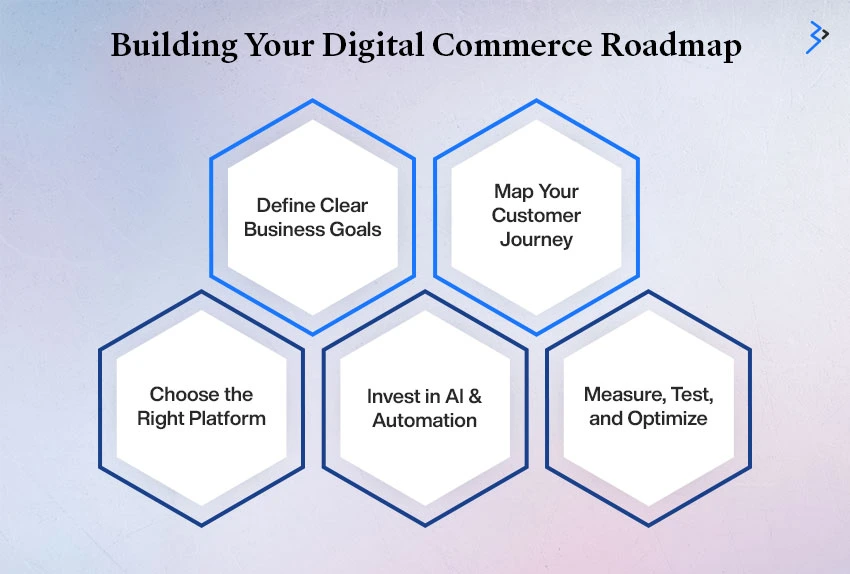Table of contents
The Digital Commerce Landscape Is Evolving — Fast
Top Trends Shaping the Future
The Technology Backbone
Adobe’s Role in Transforming Digital Commerce
Real-World Success Stories
Challenges on the Road Ahead
Building Your Digital Commerce Roadmap
The Human Side of Digital Commerce
Final Thoughts: Crafting the Future, Together
FAQs
Let’s be honest—digital commerce isn’t what it used to be. Till a few years ago, it was enough to have a basic website, a shopping cart, and maybe some discount codes. Fast-forward to today, and the landscape has dramatically shifted. Shoppers expect lightning-fast experiences, hyper-personalized recommendations, seamless checkouts, and support that knows what they want before they ask.
So, where does that leave businesses like yours? Right in the middle of a digital evolution that’s equally thrilling and, let’s face it, a little overwhelming.
But don’t worry — you’re not alone. Whether you're a seasoned eCommerce pro or just dipping your toes into the digital ocean, this guide will walk you through where digital commerce is headed, the technologies fueling its growth, and how Adobe (yes, the same folks behind Photoshop!) is powering smarter, smoother, and more scalable digital experiences.
Let’s dive in.
The Digital Commerce Landscape Is Evolving — Fast
Think about how you’ve shopped in the past year. Chances are you bought something on your phone, interacted with a chatbot, or even ordered via voice assistant. That’s because digital commerce isn’t just about selling online anymore — it’s about selling smartly, everywhere.
Real-World Glimpse
Take Starbucks, for instance. You can order ahead via their app, customize your drink down to the drizzle, earn loyalty points, and pick it up without ever waiting in line. That’s digital commerce at its best — convenient, seamless, and personal.
What’s Driving the Shift?
- Mobile-first behavior: Over 73% of global eCommerce sales happen on mobile devices.
- Customer expectations: Shoppers want instant gratification and experiences tailored to them.
- Tech evolution: AI, AR/VR, and data analytics are making commerce more intelligent than ever.
Top Trends Shaping the Future
Let’s take a moment to cut through the noise. The future of digital commerce isn’t about chasing flashy features — it’s about understanding the real trends driving how people shop, what they expect, and how businesses are adapting to meet those expectations. These are the shifts shaping the future, not just for tech giants, but for brands of every size.
1. AI-Powered Personalization
We live in the age of instant gratification, and no one wants to scroll endlessly for what they need. This is where Artificial Intelligence Development Services (AI) comes in, making online shopping faster, smarter, and more relevant.
How it’s changing the game:
- Tailors product recommendations to each user
- Optimizes pricing based on behavior and demand
- Helps businesses understand customers better through data
Example: Ever opened Netflix and thought, “Wow, how did they know I’d love this show?” Online stores now use that same predictive power to show you just what you're most likely to buy.
With tools like Adobe Sensei, even smaller retailers can deliver Amazon-level personalization—without a giant tech team.
2. Voice & Conversational Commerce
"Hey Alexa, order more coffee." Simple, right? That’s voice commerce in action — and it’s growing fast. As smart speakers and digital assistants become household staples, shopping through voice commands is becoming second nature.
Why it matters:
- Hands-free convenience
- Faster reordering for common products
- Integrated with home ecosystems
Experts predict voice commerce will reach $30 billion by 2026. The message? Brands need to start optimizing for voice search and conversational AI, now.
3. Augmented Reality (AR) Experiences
Let’s be honest — online shopping comes with its share of doubt. Will that couch really fit? Will these sunglasses suit my face?
Enter AR. It bridges the gap between the digital and physical world, helping shoppers “try before they buy” from the comfort of home.
Why AR is a game-changer:
- Increases buyer confidence
- Reduces return rates
- Enhances the user experience
4. Sustainable and Ethical Commerce
Today’s shoppers — especially Millennials and Gen Z — care deeply about what brands stand for. It’s not just about price or convenience anymore; it’s about purpose.
Key areas shoppers are watching:
- Sustainable packaging and materials
- Fair labor practices and ethical sourcing
- Carbon footprint and company values
Brands that walk the talk and embed transparency into their messaging are earning more than just sales — they’re earning long-term loyalty.
Read More - The Composable DXP Advantage: Building Agile Digital Experiences with Adobe Solutions
The Technology Backbone
Let’s face it — you can have the most beautiful storefront, catchy ads, and loyal customers, but without the right technology, your digital commerce journey is like building a skyscraper on sand. The tech backbone is what keeps modern businesses scalable, agile, and ready for whatever comes next.
In this chapter, we’ll explore the key technologies powering today’s most successful digital commerce ecosystems. These aren’t just buzzwords — they’re practical tools making a real impact.
Artificial Intelligence & Machine Learning (AI/ML)
AI isn’t just a futuristic concept anymore — it’s your silent business partner, helping you run smarter and faster.
Here’s how AI is transforming digital commerce:
- Inventory management: Predicts demand and reduces overstock
- Fraud detection: Flags suspicious transactions in real time
- Dynamic pricing: Adjusts prices based on demand, behavior, and competition
- Personalized shopping: Recommends products based on browsing and purchase history
With tools like Adobe Sensei, even non-tech teams can harness the power of AI. You don’t need to be a data scientist — just plug it in, and watch it work behind the scenes.
Cloud Platforms & Headless Commerce
The days of rigid, monolithic platforms are fading. Today’s businesses need agility — and that’s where cloud and headless commerce come in.
Why cloud-based, headless solutions matter:
- Scalability: Handle traffic spikes and expansion without crashing
- Flexibility: Customize the front end without breaking backend systems
- Speed: Make real-time updates to your UI and content
- Global reach: Deploy across regions with ease
Think of it like LEGO blocks: you build, break, and rearrange without ever needing to start from scratch.
Adobe Commerce supports headless architecture, giving you the freedom to create rich customer experiences across web, mobile app development, kiosks, and even IoT — all powered by a centralized backend.
Security & Data Compliance
In today’s data-driven world, trust is currency. Customers expect brands to protect their information, and regulators do too.
Key areas where technology supports compliance and security:
- End-to-end encryption: Keeps customer data safe during transactions
- Tokenization & secure payment gateways: Reduces risks of breaches
- Compliance tools: Helps meet standards like GDPR, CCPA, and others
- Access control: Ensures only authorized users touch sensitive data
Customers are more privacy-conscious than ever. Transparency in data handling, clear privacy policies, and visible security cues (like SSL badges) are essential for building trust.
Putting It All Together
When you combine AI, cloud flexibility, and rock-solid security, you get a tech stack that doesn’t just support your store — it elevates it. Adobe’s digital experience solutions are built with all of this in mind, so you can focus on growth while the platform takes care of the heavy lifting.
The bottom line? The right technology isn’t just nice to have—it’s what separates thriving brands from struggling ones. Invest wisely, and your digital commerce journey will be built to last.
Read More - Scaling Your eCommerce Business Effectively with Adobe Commerce on AACS
Adobe’s Role in Transforming Digital Commerce
Now, here’s where things get really exciting. Adobe has evolved far beyond creative software. Adobe Experience Cloud and Adobe Commerce (formerly Magento) are changing how businesses approach eCommerce.
Adobe Commerce at a Glance
Adobe Commerce is built to help you create personalized, B2B or B2C experiences at scale. It’s robust, customizable, and ready for growth.
Why Businesses Choose Adobe
- Unified customer profiles: Pulls data from every touchpoint to build a 360-degree view.
- AI with Adobe Sensei: Powers intelligent search, product recommendations, and personalization.
- Easy integration: Works with ERPs, CRMs, and third-party tools seamlessly.
- Scalability: From startups to global enterprises, Adobe grows with you.
Example: HP uses Adobe Commerce to serve both consumers and large enterprises, delivering personalized experiences and simplifying order workflows across multiple geographies.
Real-World Success Stories
You’ve heard the trends, explored the tech, and seen the potential. But what does digital commerce success look like in action? Let’s spotlight two brands that brought their digital transformation to life using Adobe Commerce Development Services.
Helly Hansen: Seamless Shopping Across Channels
Helly Hansen, the renowned outdoor gear brand, recognized the need for a consistent experience across its online and offline touchpoints. With Adobe Commerce, it transformed its operations and saw a measurable impact.
Here’s what they achieved:
- Unified online and in-store operations for a true omnichannel experience
- Improved mobile usability, driving a 45% increase in mobile sales
- Streamlined backend operations, reducing friction in the purchase journey
- Enabled real-time inventory visibility across platforms
By embracing Adobe’s capabilities, Helly Hansen created shopping journeys that matched their customers’ adventurous spirit, whether online or on the go.
Coca-Cola: Smarter B2B with Self-Service Power
Coca-Cola’s B2B operations needed more than just a store—they needed efficiency at scale. Through Adobe Commerce, they empowered restaurants, vendors, and partners with a modernized self-service portal.
Key benefits they unlocked:
- Centralized B2B ordering for multiple vendor types
- Customized catalogs and pricing based on partner needs
- Enhanced order accuracy and faster fulfillment
- Reduced reliance on manual entry and traditional sales calls
The result? A more agile supply chain, empowered partners, and operations that scale without complexity.
Both stories show that with the right platform, real transformation isn’t just possible—it’s measurable. Whether you’re selling ski jackets or soda, Adobe Commerce delivers real results for real brands.
Challenges on the Road Ahead
Let’s be real — digital commerce is exciting, but it’s not without its challenges. As brands race to modernize and personalize, they often run into some common roadblocks. Here’s what to watch out for, and how to navigate around them:
1. Managing Data Overload
Businesses often face more noise than insights with every tool and touchpoint collecting data.
What makes this tricky:
- Disconnected data across platforms
- Lack of clarity on what metrics actually matter
- Difficulty turning raw data into actionable insights
The fix: Use AI-powered dashboards and clear KPIs to make sense of the chaos. Adobe’s Experience Manager Services helps unify data into one intelligent customer profile.
2. Omnichannel Complexity
Customers interact across websites, mobile apps, stores, social media marketing, and even chatbots. Keeping experiences consistent? Easier said than done.
Challenges include:
- Fragmented brand messaging
- Inconsistent customer experiences across channels
- Siloed systems and teams
The fix: Leverage Adobe Optimizer Services to create seamless, connected experiences across all touchpoints.
3. Tech Skill Gaps
Not every business has a full-fledged tech team, and that’s okay.
Common struggles:
- Limited technical expertise to implement complex tools
- Dependency on third-party developers for small updates
- Slow adoption of emerging tech like AI and automation
The fix: Adobe Commerce and Sensei are built with user-friendly interfaces and automation to help business users get more done—no coding required.
Tip: Start small. Try personalized product recommendations or predictive analytics to gain confidence and build momentum.
Building Your Digital Commerce Roadmap
Feeling overwhelmed about where to begin or how to level up your digital commerce journey? Don’t worry — you’re not alone. Whether you're refreshing your existing store or starting from scratch, a clear roadmap can make all the difference.
Here’s a simple, actionable 5-step plan to help you future-proof your digital commerce strategy:
1. Define Clear Business Goals
What are you aiming for? Increased sales? Better engagement? Higher retention?
- Set SMART goals (Specific, Measurable, Achievable, Relevant, Time-bound)
- Align goals with your business stage and customer expectations
2. Map Your Customer Journey
Understanding how your audience interacts with your brand is key.
- Identify all customer touchpoints — web, mobile, in-store, social
- Pinpoint gaps, friction points, and drop-offs
- Optimize for convenience and delight
3. Choose the Right Platform
Your technology stack is your foundation. Make it count.
- Look for flexibility, scalability, and integration ease
- Adobe Commerce cloud services is a solid option with built-in AI, personalization, and analytics
4. Invest in AI & Automation
Let the tech do the heavy lifting so your team can focus on strategy.
- Use AI for product recommendations, pricing, and customer insights
- Automate workflows like email triggers, cart recovery, and reporting
5. Measure, Test, and Optimize
Digital commerce is never set-it-and-forget-it.
- Track performance with dashboards and KPIs
- A/B test changes, listen to customer feedback, and iterate often
Pro tip: Don’t chase shiny trends. Instead, choose tools and strategies that align with your brand’s purpose and your customers’ real needs.
With this roadmap in hand, you’re not just building a store — you’re creating a future-ready experience.
Read More - More Than Just Suggestions: How AI Is Deepening Customer Connections in eCommerce
The Human Side of Digital Commerce
At the end of the day, all the AI, AR, and automation in the world mean nothing without empathy. Great commerce experiences feel human — they anticipate needs, solve problems, and build trust.
What Customers Really Want
- To feel understood: Personalization that’s relevant, not creepy.
- To feel safe: Secure payments and transparent data usage.
- To feel connected: Engaging stories and responsive support.
Final Thoughts: Crafting the Future, Together
Indeed, digital commerce isn’t slowing down. And that’s a good thing. You can keep up and lead the way with the right strategy and tools (like Adobe).
It’s a journey of innovation, yes, but also of better understanding your audience, creating more joyful experiences, and building long-term loyalty.
So whether you're a solo founder or part of a global team, now is the time to explore, experiment, and evolve. And as Adobe continues to develop smarter, more intuitive commerce solutions, you’ve got a partner that grows with your vision.
Here's to what’s next — let’s build it together.
FAQs
1) What is digital commerce?
Digital commerce involves buying and selling goods/services online, including marketing, customer experience, and post-sale services across digital channels.
2) How does Adobe help with digital commerce?
Adobe Commerce offers a scalable platform for personalized eCommerce experiences, powered by AI (Adobe Sensei) and integrated customer journey management.
3) What is headless commerce, and why is it important?
Headless commerce separates the front-end from the back-end, giving brands more flexibility to deliver consistent experiences across channels and devices.
4) Is Adobe Commerce suitable for small businesses?
Absolutely. Adobe offers scalable solutions, meaning you can start small and grow without switching platforms.
5) What’s the future of eCommerce?
The future includes AI-driven personalization, immersive experiences (like AR), voice commerce, and ethical, customer-first practices — all powered by smart platforms like Adobe.
Related Articles
Digital Transformation
The New Era of Enterprise AI: Adobe Experience Platform Agents to Boost Human Collaboration
Digital Transformation
Headless Commerce Accelerated: Building Future-Ready Storefronts with Adobe Commerce & Modern Frameworks
Digital Transformation
Beyond the Launchpad: Why Dedicated Post-Migration Support is Your Shopify Success Secret Weapon

